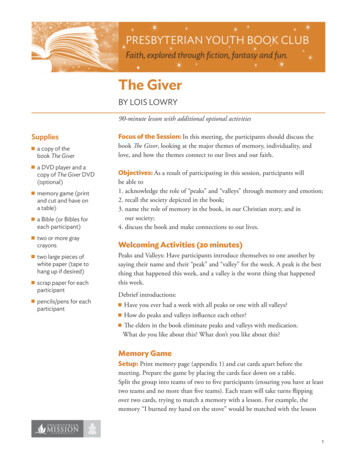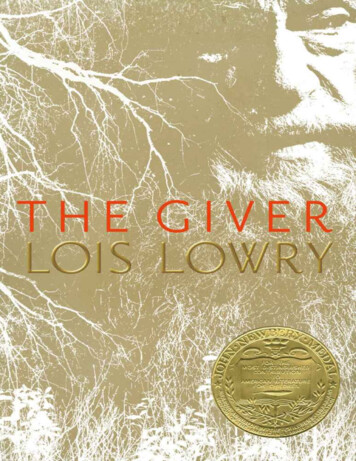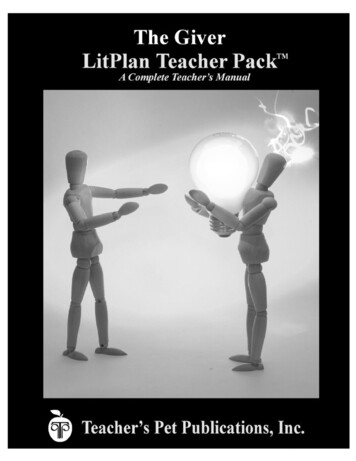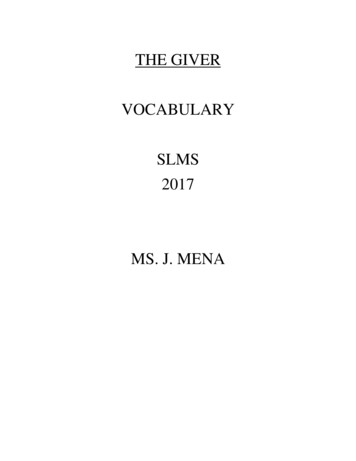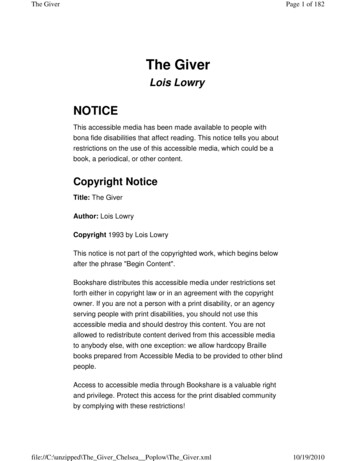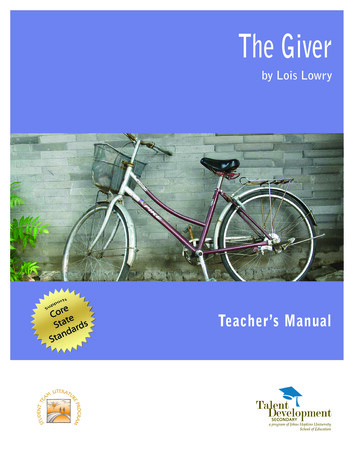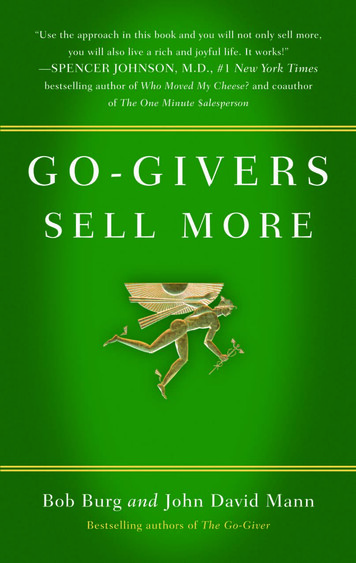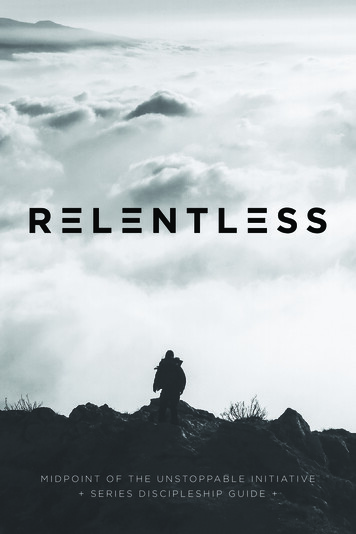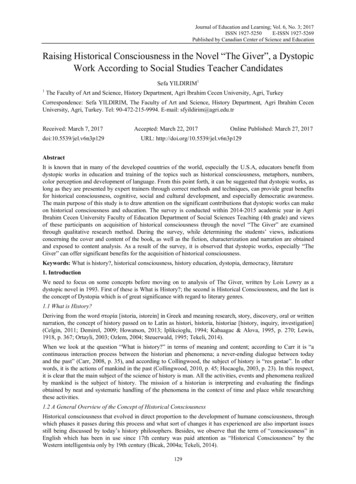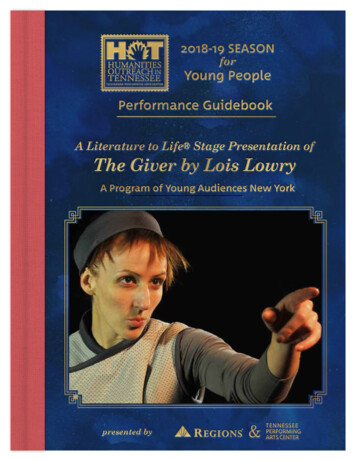
Transcription
2018-19 SEASONforYoung PeoplePerformance GuidebookA Literature to Life Stage Presentation ofThe Giver by Lois LowryA Program of Young Audiences New Yorkpresented by&
From our Season SponsorFor 135 years Regions has been proud to be a part of the Middle Tennessee community,growing and thriving as our region has. From the opening of our doors on September 1, 1883,we have committed to this community and our customers.One area that we are strongly committed to is the education of our students. We are proudto sponsor TPAC’s Humanities Outreach in Tennessee (HOT). What an important program thisis – reaching over 30,000 students, many of whom would never get to see a performing artsproduction without this local resource. Regions continues to reinforce its commitment to thecommunities it serves, and in addition to supporting programs such as HOT, we have close to 200associates teaching financial literacy in classrooms this year.Thank you, teachers,for giving your students this wonderful experience. You are creating memories of a lifetime, andRegions is proud to be able to help make this opportunity possible.
The GiverTPAC Performance GuideforA Literature to Life StagePresentation of The GiverDear Teachers,By Beth Anne MusikerThe seemingly utopian community of The Giver has keptthis intriguing, award-winning book in circulation for 25years. This Guidebook is designed to help you preparestudents for an authentic and deeply connectedexperience of A Literature to Life Stage Presentation ofThe Giver at TPAC, through immersive activities anduseful information about the production.In addition, you will find the Literature to Life Teacher’sResource Guide on the TPAC Education We hope you will find both resources useful andmeaningful. We thank you for choosing to bring yourstudents to experience this fascinating story through ALiterature to Life Stage Presentation of The Giver atTPAC!Enjoy!TPAC Education12-3Introduction: Meet thePerformance and Company4-5Synopsis6Lesson 1: The Art ofStorytellingLesson 2: Memory MonologuesLesson 3: VerbatimAdaptations91115Additional Activity Suggestionsand Resource LinksAlso Recommended:The Literature to Life Teacher’sResource GuideYou will find thematic activities anddiscussion topics including:UtopiaObjectivityManipulation & CensorshipIndividual vs. CommunityLois LowryEthical DilemmasGoals and AspirationsScience Fiction
A Literature to Life presentation is a unique ninety-minute theatrical and educational experiencecomprised of a one hour verbatim solo performance and pre / post show interactive audiencediscussion facilitated by a Literature to Life Master Teaching Artist.The GiverBy Lois LowryPerformed by Aurea TomeskiAdapted and Directed by Elise ThoronCostume Design by Debra OtteAurea Tomeski is the soloperfomer in The Giver.Aurea Tomeski has been captivating national audiences with herperformance of The Giver since the spring of 2017. A pageant kid fromthe age of 5, Aurea grew up on stage and in front of the camera. She is agraduate of The New School for Drama’s MFA program with aconcentration in Acting. Classically trained at the Royal Academy ofDramatic Art in London and as a professional intern at A Noise Within inSouthern California, Aurea has performed in numerous Shakespeareanproduction on both the East and West Coast as Lady Macbeth, LadyCapulet, and Emilia. She most recently completed a tour withShakespeare Theatre of New Jersey as Titania in "A Midsummer Night'sDream". Aurea also holds a particular passion for developing newtheatrical works in concert with writers and directors. She recently hadthe opportunity to create the role of Regina/Deirdre in "Dead SpecialCrabs" at The Barrow Group and the role of Carradine in “Tapefaces,” byJon Kern, a play focusing on the particular difficulties of being anAsian/Caucasian mix in the modern world. You may have seen her ontelevision as a clueless mother-to-be on TLC’s “I Didn’t Know I WasPregnant,” or as a crime-solving best friend in Discovery ID’s “Scorned”.Aurea also does some work behind the scenes as a producer, with hermost recent project being "Man On A Wire," a musical retelling of highwire walker Philippe Petit's harrowing feat between the World TradeCenter towers.Farbeon Saucedo: Teaching ArtistFarbeon has been a teaching artist with Young Audiences New York’s Literature to Life program since2015. As a community-based Hip Hop artist, educator and agent of change, Farbeon works to developpedagogy that moves beyond high-stakes testing and bridges the gap between the arts, academics andsocial youth development. He has taught Poetry, Performance, Song-Writing, Digital Media, Photography& Hip-Hop History and Culture at high schools, universities and community centers throughout the UnitedStates and abroad. Whether in the studio, on stage, behind the lens of a camera or in a classroom,Farbeon is dedicated to leveraging artistic craft and process to bring about dialogue, peace,understanding and to pave the way for the next generation of young ARTivists.
About this Performance and CompanyHow do you take a classic book for young audiences that presents acommunity’s worth of characters in a highly-defined, futuristicsetting and adapt it into a compelling one-woman touring show? ALiterature to Life Stage Presentation of The Giver answers thiscomplex question.The production borrows elements of a memory play, chambertheatre and storytelling. In this stage presentation, one actressdraws us into the world of The Giver, serving as both narrator and allthe characters. She shares the story from a very minimal set usingonly stage boxes, a chair and a folder. The lighting and sound effectsenhance the production by defining space and location. Chamber theatre is a method of adapting literary works tothe stage using as much of the work's original text as possibleand often using minimal and suggestive settings. Narration is typically included in the performed text andthe narration may be shared by multiple actors in the piece.The concept was first introduced by Professor Robert S.Breen (1909-1991) to his Oral Interpretation Classesat Northwestern University in the last 1940s. Memory Play is a term coined by Tennessee Williams todescribe non-realistic dramas, such as his play, The GlassMenagerie. In this play the audience is introduced to the pastas it is remembered by a narrator, complete with characters'thoughts, fears, emotions, and recollections. Because it ismemory and non-realistic it can be presented with unusualfreedom of convention.Literature to Life is the American Place Theatre’s educationprogram, providing performance-based literacy opportunities forstudents, along with a spark of imagination. Through “verbatim”one-performer adaptations of American literature, Literature toLife adaptations include much of the story’s narration within theperformed text— a key feature of chamber theatre.This approach provides a feeling of intimacy in the performance,allowing audience members to feel as if the story is being told justfor them. This minimalist style also insists that the audience focuson the story being shared and use their own imaginations as they“see” the imagery of story unfold.3The GiverBy Lois LowryAdaptation and Direction byElise ThoronThis Literature to Life Awardwinner marked the firstyoung adult novel on theLiterature to Life roster.Adapted by Elise Thoron,this piece features sixtyminutes of soloperformance focusing onthe relationship betweenthe young Jonas and hismentor, The Giver. As Jonastrains to become theReceiver of Memories, theburied truth about theworld that he was born intobecomes hauntingly clear toboth Jonas and theaudience. Surrounded by apre and post showinteractive discussion, theaudience will explorethemes includingIndividuality, Ethics andSocial Constructs.
SynopsisThe Giver is adapted from a 1993American young adult novel by Lois Lowry.Set in a society which at first appears to beutopian it is gradually revealed to be, infact, dystopian. The novel is written fromthe point of view of Jonas, an eleven-yearold boy living in a futuristic society that haseliminated all pain, fear, war, and hatred infavor of “sameness.”As Jonas receives these memories, herealizes how bland and empty life in hiscommunity really is and begins to strugglewith all the new emotions and conceptsintroduced to him, wondering whether theyare inherently good, evil, or in between,and if it is even possible to have onewithout the other.While the memories make Jonas’s life richerand more meaningful, he longs to sharewhat he’s learning with the people he loves.As Jonas gains knowledge, he grows deeplyfrustrated with the members of hiscommunity. The Giver has felt this sameway for years and is encouraging to Jonas.While “sameness" has eliminated prejudice,competition and other problems in thecommunity, it has also eradicated bothemotional depth and choice from theirlives. When not with the Giver, Jonas helps hisfamily take care of a problematic new child,Gabriel. Jonas helps Gabriel to sleep bytransmitting soothing memories to himevery night and begins to develop arelationship with Gabriel that mirrors thefamily relationships he has experiencedthrough the memories.At the beginning, we find Jonasapprehensive about the upcomingCeremony of Twelve, when he will be givenhis official life-long assignment as a newadult member of the community. Jonas isselected for the highly honored position ofReceiver of Memory, the sole keeper of thecommunity’s collective memory.When Gabriel is in danger of being released,the Giver reveals to Jonas that release is thesame as death. Jonas’s horror at thisrevelation inspires the Giver to help Jonasdevise a plan to change things in thecommunity forever.As Receiver his responsibility is to store allthe past memories of the time beforeSameness, for the times when the wisdomgained from history might be needed to aidthe community's decision making. Jonasreceives the memories of the past, goodand bad, from the current Receiver, a wiseold man who is known as the Giver.Together they plan for Jonas’ escape fromthe community and a journey to enterElsewhere. However, Jonas is forced toleave earlier than planned when his fatherexplains that Gabriel will be released thefollowing day.4
In order to save Gabriel, Jonassteals his father’s bicycle, somefood and sets off for Elsewhere.As they travel, they graduallyenter a landscape full of color,animals, and changing weather,in addition to experiencinghunger, danger, and exhaustion.Avoiding search planes, Jonasand Gabriel continue theirjourney until heavy snow makesbike travel impossible. Halffrozen, but still comfortingGabriel with memories ofsunshine and friendship, Jonasclimbs a high hill. Finding thesled from his first transmittedmemory waiting for him at thetop, Jonas and Gabrielexperience a glorious downhillride on the sled. Below andahead of them, are the twinklinglights of a village at Christmas.They hear music and Jonas issure that someone there isexpecting them. how could you describe a hill and snow tosomeone who had never felt height or wind orthat feathery, magical cold?-Lois Lowry, The Giver5
Note: Teachers may want to consider the “Objectivity” activityin the Literature to Life Resource Guide prior to the activitybelow.LESSON ONEThe Art of Storytelling (40 – 50 minutes)Objective: Students will explore what it takes to be aneffective storyteller and actor.Materials: Copies of The Giver excerpt (page 8 in thisguidebook)Now, too, he could feelcold air swirlingaround his entire body.He felt it blow againsthis hands where theylay at his sides, andover his back.-Lois Lowry, The GiverWhat do you know about Storytelling?Begin by asking students what they know about storytelling and acting. You may want toinclude some of the following prompts: What do you want to see in a performer sharing a story from the stage? Is there a difference between experiencing an actor in a role and someone reading aloudfrom literature? Responses might include, POV, narrative, dialogue, embodying the role vs.simply telling the story, etc. What do you think are the qualities of a great story and storyteller? Do you have a friend who shares the stories of their life in a way that is so entertaining youcan’t wait to hear about their latest adventure?o Can you can hear their voice and style telling you a story even when they are notthere?o Are you that great storyteller? What are some of the ways a storyteller might use their body, voice, tempo and emotionsto help convey the story.Activity: Let’s Tell a Story!Provide each student with a copy of The Giver excerpt, found on page 8 in this guidebook.Allow students a couple of minutes to read the excerpt to themselves. Briefly discuss the passage to ensure comprehension. Have students gather in groups of 4 – 6. Make sure each group has a space in which towork. Instruct students to divide the text amongst their group so that each person has a sectionfor which they are responsible. Ask them to think carefully about how to divide the text.What choice will best serve the storytelling? Explain that they will work “round-robin” style, taking turns reading the passage out loud totheir fellow group members. Allow time for the groups to rehearse before performing for the rest of the class. Give themtime to experiment and refine their performance choices. Side coach as needed and sharethe Rehearsal Tips with students. Have each group perform for the rest of the class.6
Final ThoughtsFollowing all the performances take some time to process the experience with the students: What were the challenges of developing a performance of this descriptive memorypassage? How did it differ from playing a role in a play?How were you able to distribute and coordinate the performance across all the groupmembers?Did you feel you were successful? What made you successful?What changes would you make if you could do it again?Rehearsal TipsAs you prepare to share your groupinterpretation with the class:o Explore the ways in which eachreader might use their voice toconvey the action and emotions.o How can your body also addmeaning to the narrative? Practicedifferent postures, gestures andmovements for the greatest impactand variety.o Imagine the sight and feel of thesnow for yourself. Use your ownpersonal memories and impressionsto help the audience experiencesnow for the first time.o Be bold with your choices!7
From Chapter Eleven of The Giver, by Lois LowryOne part of his consciousness knewthat he was still lying there, on the bed, inthe Annex room. Yet another, separatepart of his being was upright now, in asitting position, and beneath him he couldfeel that he was not on the soft decoratedbedcovering at all, but rather seated on aflat, hard surface. His hands now held(though at the same time they were stillmotionless at his sides) a rough, damprope.Jonas felt nothing unusual at first. Hefelt only the light touch of the old man’shands on his back.He tried to relax, to breathe evenly. Theroom was absolutely silent, and for amoment Jonas feared that he mightdisgrace himself now, on the first day ofhis training, by falling asleep.Then he shivered. He realized that thetouch of the hands felt, suddenly, cold. Atthe same instant, breathing in, he felt theair change, and his very breath was cold.He licked his lips, and in doing so, histongue touched the suddenly chilled air.And he could see, though his eyes wereclosed. He could see a bright, whirlingtorrent of crystals in the air around him,and he could see them gather on thebacks of his hands, like cold fur.It was very startling; but he was not atall frightened, now. He was filled withenergy, and he breathed again, feeling thesharp intake of frigid air. Now, too, hecould feel cold air swirling around hisentire body. He felt it blow against hishands where they lay at his sides, and overhis back.His breath was visible.Beyond, through the swirl of what henow, somehow, perceived was the thingthe old man had spoken of—snow—hecould look out and down a great distance.He was up high someplace. The groundwas thick with the furry snow, but he satslightly above it on a hard, flat object.The touch of the man’s hands seemedto have disappeared.Sled, he knew abruptly. He was sittingon a thing called sled. And the sled itselfseemed to be poised at the top of a long,extended mound that rose from the veryland where he was. Even as he thoughtthe word “mound,” his new consciousnesstold him hill.Now he became aware of an entirelynew sensation: pinpricks? No, becausethey were soft and without pain. Tiny,cold, featherlike feelings peppered hisbody and face. He put out his tongueagain, and caught one of the dots of coldupon it. It disappeared from his awarenessinstantly; but he caught another, andanother. The sensation made him smile.The sled, with Jonas himself upon it,began to move through the snowfall, andhe understood instantly that now he wasgoing downhill. No voice made anexplanation. The experience explaineditself to him.8
LESSON 2Defined by Our MemoriesObjective: Students will explore the ways in which memories defineus by writing a memory monologue suitable for performance.Materials needed: pen or pencil and notebook paperNote to teacher: This lesson has two parts. You can choose to doonly Part A, or, continue with Part B in the same class period, if timepermits, or on another day.“If you were to belost in the river,Jonas, yourmemories wouldnot be lost with you.Memories areforever.”― Lois Lowry,The GiverPart A – (30 minutes)Do You Remember?Discuss the role of memories in our lives with your students. You may want to include some of thefollowing prompts: How many of you think of yourselves as having a good memory? What makes you think you have a good memory? In your memories, what stands out the most: the sights, sounds, smells or emotions attachedto events in your life? How would you say our memories contribute to the way we define ourselves or our families?Our community or culture? Have students take a couple of minutes to write down some memories that may be bubblingup for them based on the discussion. Ask students to focus on a favorite memory in which they felt particularly happy, excited, oraccomplished. Maybe it was a special event or adventure of some kind. Perhaps they have amemory they think of as defining who they are today. Ask students to consider why the memory they’ve selected is one of their favorite memories.Is it because of the people involved, the activities, the location, or something else? Model:Share one of your own favorite, defining memories with your students. Once students have selected a memory invite them to close their eyes and see it taking placeagain; visualize it in all its details.Writing a Memory Monologue Once students have had time to visualize, invite them to write out their selected memory onnotebook paper, from their own point of view. Guide students to write their memory as if it were a monologue to be performed and sharedwith an audience from a stage:o Ask students how they might share that memory in a way that would be interesting,entertaining, helpful, or meaningful to someone in the audience?o Is this memory monologue best told by you or do you need to create a character to tellthis memory more effectively?o Allow your responses to shift the way you write this memory.9
Final ThoughtsAt the conclusion of the writing assignment ask students: What they think the impact would be on their lives if the memories they wrote about hadnever happened? How would they be different? What would it be like for an entire community or society to have no shared memories, noknowledge of their own history? How might that impact the way the community definesthemselves?Part B (30 – 40 minutes)Bringing the Monologue to LifeStudents will use the memory monologues they wrote in Part A for this activity. Please be sure toshare the definition of a memory play on page with your students. Have students pair up and decide which partner will be A and which B? Have all the Bs readtheir memory monologue aloud to their respective As. Then switch and have all the A’s readtheir memories to their respective Bs. Allow time for revisions before having partners swap their written memory monologues withone another. Thinking about these written memories as monologues, Partner A will now direct Partner B ina performance of Partner A’s memory story. Partner B will then direct Partner A in a performance of Partner B’s memory story. Instruct students that they are to direct their partner to deliver this memory monologue forthe greatest impact on the audience:o What do they want the audience to understand or feel after experiencing themonologue?o How can they bring the story and images to life?o How can they use body language, facial expression, gesture, voice, etc. tocommunicate their ideas?o How can you embody someone else’s story?o How does an actor make the picture/images come alive for the reader/audience?Final ThoughtsHave students respond to the performances: What did they notice about the memory monologues? What choices helped bring the stories to life? In what ways were each pair’s performance choices the same or different? If you had an opportunity to do it again, what would you change?10
LESSON 3One-Person Verbatim Adaptation(45 – 60 minutes)Objectives: Students will edit an excerpt of The Giver with manycharacters to create a verbatim adaptation to be performed by oneperson.Materials needed: A copy of The Giver excerpt, pen or pencil,notebook paper. (To print the excerpt, print pages 15-16 of thisPDF document.)Introduction:Is it a book or a play? Have a discussion with students about a one person show and verbatimadaptation. You may want to include some of the following prompts: What are some of the ways one performer could bring The Giver to life? What will be some of the challenges the performer faces? How can one performer play all the characters? What’s the difference between a one-person show and a larger cast? How might one adapt a novel for the stage to be performed by one individual. What do you think it means to create a “verbatim” adaptation? Very important thatstudents understand this concept before moving to the activity that follows. Would we want to put the entire book on stage verbatim? Why or why not? If not the whole book, then how would an adapter choose what to keep and what to editout? Introduce the vocabulary Verbatim, Adaptation and Verbatim Adaptation.Verbatim means in exactly the same words as were used originally.Verbatim Adaptation as used by Literature to Life means that everything the performersays is in the exact words as they appear in the original book. It does not mean, however,that everything in the novel appears on stage. There is much editing and distilling down ofthe novel in the stage production, yet everything heard on stage does appear in the bookand the order of events remains the same, as well.Activity:You are the AdapterExplain to the students that they will create their own verbatim adaptation of The Giver excerptthey are receiving.1. Begin by pairing off. Each student will need a copy of The Giver excerpt included with thislesson. Have students read the excerpt individually and then discuss the plot points withtheir partner.11
2. In this activity, students will work with their partner to create their own adaptations of thisexcerpt. Students may mark up the text by crossing out what they no longer need, etc.They may want to rewrite the sections they are using for easier reading.3. Consider:o Which portions of the excerpt must stay, and which they can edit out and stillmaintain the main ideas of the excerpt?o How can one person can embody all these characters and tell this story?o How can the adaptation and/or direction and set design be incorporated to assistthe performer?4. Prepare to share:o When they are satisfied with their written edits, each pair will decide which personwill direct and which will become the actor/storyteller.o If a sturdy box or platform strong enough to sit on is available, let students knowthey may use one box and one chair for their set pieces. Two chairs will work in lieuof a box, if not available.5. Allow students time to rehearse and refine their choices. Side coach as needed.o Have each pair share their performance with another pair.o If time permits, ask for a few pairs to volunteer to perform for the full group.Final ThoughtsFollowing the performances ask students about their experience: What were some of your challenges in adapting the excerpt? Was it difficult to keep it verbatim? Did you want to make another choice regardingthe text itself? How did you overcome these challenges? Did preparing the performance add a new set ofchallenges? How did you work on this adaptation differ fromyour work performing the first snow?12
Excerpt for Verbatim Adaptation ActivityExcerpt from The Giver by Lois Lowry“Who wants to be the first tonight, for feelings?” Jonas’s father asked,at the conclusion of their evening meal. It was one of the rituals, theevening telling of feelings. Sometimes Jonas and his sister, Lily, arguedover turns, over who would get to go first. Their parents, of course, werepart of the ritual; they, too, told their feelings each evening. But like allparents—all adults—they didn’t fight and wheedle for their turn.Nor did Jonas, tonight. His feelings were too complicated this evening.He wanted to share them, but he wasn’t eager to begin the process ofsifting through his own complicated emotions, even with the help that heknew his parents could give.“You go, Lily,” he said, seeing his sister, who was much younger—onlya Seven— wiggling with impatience in her chair.“I felt very angry this afternoon,” Lily announced. “My Childcare groupwas at the play area, and we had a visiting group of Sevens, and theydidn’t obey the rules at all. One of them—a male; I don’t know his name—kept going right to the front of the line for the slide, even though the restof us were all waiting. I felt so angry at him. I made my hand into a fist,like this.” She held up a clenched fist and the rest of the family smiled ather small defiant gesture.“Why do you think the visitors didn’t obey the rules?” Mother asked.Lily considered, and shook her head. “I don’t know. They acted like . . .like . . .” “Animals?” Jonas suggested. He laughed.“That’s right,” Lily said, laughing too. “Like animals.” Neither childknew what the word meant, exactly, but it was often used to describesomeone uneducated or clumsy, someone who didn’t fit in.“Where were the visitors from?” Father asked.Lily frowned, trying to remember. “Our leader told us, when he madethe welcome speech, but I can’t remember. I guess I wasn’t payingattention. It was from another community. They had to leave very early,and they had their midday meal on the bus.”Mother nodded. “Do you think it’s possible that their rules may bedifferent?13
And so they simply didn’t know what your play area rules were?”Lily shrugged, and nodded. “I suppose.”“You’ve visited other communities, haven’t you?” Jonas asked. “Mygroup has, often.”Lily nodded again. “When we were Sixes, we went and shared a wholeschoolday with a group of Sixes in their community.”How did you feel when you were there?”Lily frowned. “I felt strange. Because their methods were different.They were learning usages that my group hadn’t learned yet, so wefelt stupid.”Father was listening with interest. “I’m thinking, Lily,” he said,“about the boy who didn’t obey the rules today. Do you think it’spossible that he felt strange and stupid, being in a new place with rulesthat he didn’t know about?”Lily pondered that. “Yes,” she said, finally.“I feel a little sorry for him,” Jonas said, “even though I don’t evenknow him. I feel sorry for anyone who is in a place where he feelsstrange and stupid.” “How do you feel now, Lily?” Father asked. “Stillangry?”“I guess not,” Lily decided. “I guess I feel a little sorry for him. Andsorry I made a fist.” She grinned.14
Activities for Additional Exploration Have students explore the nature of a community with very specific and proscribedceremonies and rituals. Have them create families of 4 and demonstrate a ceremonyor ritual. To add the experience of what it means to be an outsider, have onemember of each “family” shift groups with the expectation that that they will pickup their new family’s ritual without explanation. What is the role of music in student’s life? Explore what it would mean to live in aworld where there is no color, no music, no choice. Have students create a familyunit that either lives with music or not and then randomly switch them to the otherparameters. Have students explore the relationship between personal choices and careerdecisions? What jobs and careers are available to meet individual and societal needslocally, regionally, and nationally? What if society dictated your job by the time youwere 13 based on who you’ve presented yourself to be to date? Explore the different POVs in The Giver along with an assessment of the jobsselected for each person by The Elders. Ask students to consider what power societyshould have to promote or limit freedom, choice, and desire. Shifting from character to character – how can distilled acting choices help the actortransition quickly between each character, repeatedly. Explore the Resource Guide from Literature to Life where you will find activitiesacross a broad range of curriculum.Links and other info:Literature to Lifehttp://literaturetolife.orgLiterature to Life Teachers Resource Guide (on TPAC’s Performance debooks/More about The American Place Theatrehttps://en.wikipedia.org/
The Giver A Literature to Life Stage . Dear Teachers, The seemingly utopian community of The Giver has kept this intriguing, award-winning book in circulation for 25 years. This Guidebook is designed to help you prepare students for an authentic and deeply connected experience of A Literature to Life Stage Presentation of

